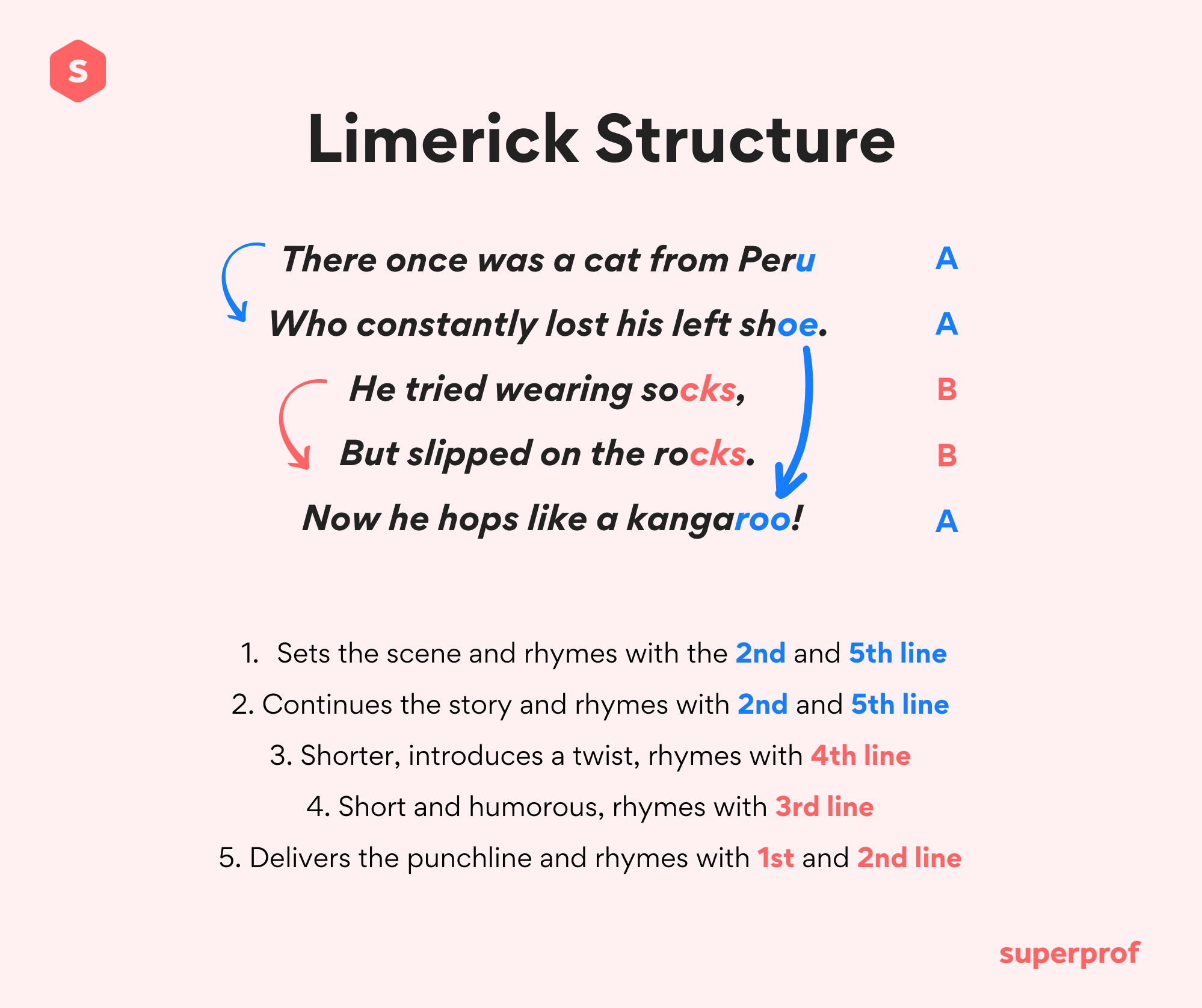My highest aspiration in life is to serve as the Limerick Laureate of Nantucket.
Alan C. Baird
Writing a limerick can be a difficult task, you’ve got just 34 syllables to express your idea, and ideally, make it funny too. If you’re an aspiring poet or just an interested reader we’ve got the guide to teach you everything you need to know about this 5-lined poem. But first, what exactly is a limerick?
5 lines
AABBA rhyme scheme
Humorous (with a punchline)
Anapestic trimeter

What Are Limericks?
A limerick poem or simply limerick is often lighthearted in theme, but its structure is no joke. Limericks as poetry originated as folkloric drinking songs in England, complete with obscenity and topics to be avoided in polite company.
The limerick as poetry follows the structure of the choruses from these songs and still tends to include humor and obscenity like the songs, but you can certainly write limericks that are humorous without including the drunken obscenity popular with sailors!
Unlike Epic poetry, limericks are supposed to be fun, include humor, and even rudeness or the kinds of things you can only say in front of certain people.

Your typical limerick is written across 5 lines. The AABBA rhyme scheme means that the first, second, and fifth lines rhyme with each other while the third and fourth lines, which are always shorter, rhyme with one another.
If you've heard a limerick before, it's likely the one that goes There once was a man from Nantucket, however, most versions of this one can't be repeated so here's a much cleaner version that the whole family can enjoy:
- There once was a man from Nantucket,
- Who kept all his cash in a bucket.
- But his daughter, named Nan,
- Ran away with a man,
- And as for the bucket, Nantucket.
While hardly a limerick that will have you rolling about the floor laughing, it expertly illustrates the rhyme scheme, the meter, and the wordplay and humor that's an essential part of them.
If you've heard limericks before, you'll naturally read them using the accented syllables that give them their distinctive feel. When writing a limerick, you have some leeway with how many syllables you include in each line, but you can't alter how many accented syllables are included.
The longer lines (lines 1, 2, and 5) have 3 accents or stressed syllables. The shorter lines (lines 3 and 4) have only 2 accents. There are lots of different ways to write poetry, but limericks are a strict type of poetry and don't afford poets as much freedom.
Let's look more closely at the rules that underpin limericks.
The Rules to Writing Limericks
As with everything in literature, rules can be bent and broken, but if you want your limerick to sound like a limerick, these are the main "rules" you should look to follow.
Much like the number of lines, there are 5 main rules to writing a limerick:
- Limericks have five lines
- Limericks follow the AABBA rhyme scheme
- Lines 1, 2, and 5 have 3 stressed syllables, while lines 3 and 4 have two.
- Limericks have a humorous punchline on line 5.
- The punchline usually refers back to the initial rhyme from the first line.
Following these rules will make your limerick sound more authentic, but certain liberties can be taken with them once you start to explore the structure and style of limericks.

Superprof Graphics
Rhyme Schemes in Limericks
We've already mentioned that the rhyme scheme in a limerick is AABBA and that lines 1, 2, and 5 rhyme and lines 3 and 4 rhyme. If you're unfamiliar with the conventions for rhyme schemes, letters are used to label the rhyme so the same letter means that the rhymes are in that order.
For example, an ABAB rhyme scheme has alternating rhymes where the first and third lines rhyme with one another and so do the second and fourth. A Ballad poem follows the ABCB rhyme scheme, but you can't apply the ballad rhyme scheme to a limerick.
You can add another letter of the alphabet for every new rhyme, allowing for more complex rhyme schemes, but for limericks, the AABBA structure is the only one that works. Otherwise, you'd end up with a different kind of poem.
- There once was a man from Nantucket,
- Who kept all his cash in a bucket.
- But his daughter, named Nan,
- Ran away with a man,
- And as for the bucket, Nantucket.
The words (or syllables) underlined in this limerick are the A rhymes in our AABBA rhyme scheme. The words in bold are the B rhymes in the rhyme scheme.
The second and third A rhymes in this example are the same word. While this is common in limericks, it's not required and you'll find that many limericks introduce a new word for the end of the fifth line rather than simply repeating the end of the third line.

Rhythm and Meter in Limericks
In poetry and verse, rhythm is important and limericks have a very clear rhythm. If you read a limerick with a different rhythm, you'll find that it doesn't sound like a limerick at all.
You might be familiar with different kinds of sonnets, which commonly use iambic pentameter. Sonnets are read differently from limericks because their meter is different.
Limericks are anapestic. This means that the third syllables are stressed and follow two unstressed syllables. As we mentioned earlier, the A lines in a limerick have three stressed syllables while the B lines have just two.
There are a few ways we could explain this, but if you think of a heartbeat as a da-DUM, the stressed syllables are the DUM.
With a limerick, the stresses would be as follows:
- da DUM da da DUM da da DUM
- da DUM da da DUM da da DUM
- da DUM da da DUM
- da DUM da da DUM
- da DUM da da DUM da da DUM
Unlike when writing Haiku poems, syllables in a limerick can be added or removed, but the more you deviate from this structure, the clunkier and more awkward your limerick will feel.
If we go back to our earlier example, which follows the AABBA rhyme scheme, we can highlight the stressed syllables (in bold):
- There once was a man from Nantucket,
- Who kept all his cash in a bucket.
- But his daughter, named Nan,
- Ran away with a man,
- And as for the bucket, Nantucket.
Consider enrolling in poetry classes to explore your creativity, enhance your writing skills, and learn from experienced poets, all from the convenience of your own home. These classes provide valuable feedback and inspiration, helping you to develop your unique voice and refine your poetic craft.
Tips and Tricks for Writing a Good Limerick
All art, including limericks, is subjective. In addition to following the rules and reading other limericks to get a better idea of what you need to do, here's some more advice on writing good limericks.

The rules will only take you so far. There are things beyond the typical poetic structure, rhyme scheme, meter, etc. that will make your writing more like a limerick.
These two tips will help make your limerick better:
- The first line of a limerick introduces a person or a place
- The person or place in the first line is also part of the A rhyme scheme.
- The last line is the punchline.
- The situation established in lines 1 and 2 starts to become silly or absurd during lines 3 and 4.
When you first practice writing limericks, start with your traditional first line:
There once was a man/woman from [place] or There once was a man/woman called [name]
From there, look to obvious rhyming words to give you an idea for lines 2 and 5. After that, you can tie everything together with your B lines for lines 3 and 4, while you introduce something silly or rude.
As I was doing research for top tips & tricks for writing limerick poems, I came across an online poem generator. Initially, I was shocked to find that an online tool can provide such beautiful poems. Even though you can't expect it to understand and generate subtleties in poems better than humans do, I still believe it to be a useful tool.
Here's another example of a limerick that uses these rules.
- There was a young lady of Norway
- Who hung by her toes in a doorway.
- She said to her beau
- ‘Just look at me Joe,
- I think I’ve discovered one more way.

Why You Should Write Limericks
Don't think that limericks can't teach you anything about poetry just because they're silly and often rude. After all, they can teach you about rhyme schemes, meter, structure, and the common elements of poetry that occur in almost every kind of poetic writing, no matter how serious or silly it might be.
Limericks are also a great way to express your creativity. They give you plenty of options to write creatively and experiment with humor, wordplay, and a fixed comedic structure.
Many creative people find that writing following a strict structure makes them think more creatively and helps them become better writers. Limericks aren't the only thing you can try writing with a strict structure, but the fact that they're very short makes them a useful type of poetry for practicing your writing.
Practice makes perfect, but if you want guidance, why not learn more about poetry and writing from online poetry classes on the Superprof website?
Whether it's limericks, epic poetry, Haikus, or even free verse poetry, you can find plenty of qualified and experienced tutors.
















I like to create limericks
cool
Like this and going to work on writing a limerick with it! You!
Thank you, Nancy! Good luck writing your limerick!